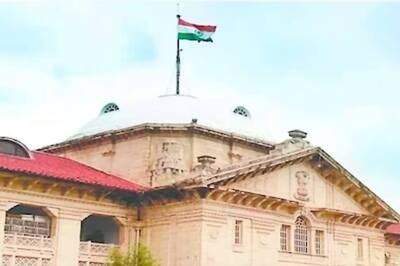
views
Northeast India was not very long ago riddled with insurgencies in almost every state. These insurgent groups perpetuated violence in the region for decades. Today, the security situation in Northeast India has been turned around, and quite remarkably so. Friday was a particularly historic day for the region, especially for Assam, as the United Liberation Front of Asom (ULFA), arguably once South Asia’s most feared insurgent group, signed a peace agreement with the Government of India.
Out of all the peace agreements signed with a series of other groups, this one stands out in particular. It signals a generational shift in this part of the country and reinforces the now popular belief that the dark days of violence, extortion and bandhs are over, for good.
Responsible for several attacks and once having the ability to bring life to a standstill in Assam and the region, ULFA today has been reduced to the very margins – which is why it has had to sign a peace deal with the Centre. The emergence of ULFA out of the anti-immigration movement in Assam also triggered the emergence and strengthening of insurgent groups in other Northeastern states. There was a time when it would be hardly surprising for regular reports to suggest that the insurgent groups in various Northeast states would operate in close coordination with ULFA.
With the pro-talks faction of ULFA now having signed a peace deal with the Central government, the only faction that remains is the ULFA (Independent), led by Paresh Barua, operating mostly at the India-Myanmar border. After the signage of the peace accord with the pro-talks faction of ULFA, Barua’s wing will fight an even lonelier and non-kinetic battle.
Insurgent activities in the Northeast as a whole have come down remarkably in the past decade, and hardly anyone in the region now takes these groups seriously. As a matter of fact, the rapidity with which a series of peace agreements are being signed in the Northeast is a testament to the depleted capabilities of insurgent groups, whose only recourse now is to lay down their arms and join the mainstream.
In October, Union Home Minister Amit Shah had revealed that there has been a 65 per cent fall in incidents of terrorism, left-wing extremism and insurgency in the Northeast. Last year, Shah said that attacks on security personnel have been reduced by 60 per cent while civilian casualties were down 89 per cent. Today, insurgent groups neither have the power nor the influence to bring day-to-day life to a standstill in the region, a feature which only 10 years ago used to be a regular affair. The infamous “bandh” culture has been dismantled, paving the way for uninterrupted economic activity.
The Steep Rise and Inglorious Fall of ULFA
ULFA was formed on April 7, 1979, to seek the “restoration of Assam’s sovereignty”. Beginning in 1990, the government attempted to wean away members of the outfit. This was after the ULFA was declared a terrorist organisation, and its deputy commander-in-chief, Heerak Jyoti Mahanta, died in December 1991. At its height, ULFA engaged in all sorts of illegal activities, ranging from assassinations, kidnappings, IED blasts, drug trafficking, extortion to even mass killing of innocent civilians.
Mahanta had opposed surrenders, but they began at a significant scale after his death. In 1992, a large section of second-rung leaders and members laid down their arms. The total number of ULFA militants to have surrendered has gone up to 8,718 this year. The original ULFA underwent a split after the outfit’s top leadership, including Arabinda Rajkhowa, was arrested in Bangladesh and handed over to India in 2008. Three years later, Rajkhowa and his group decided to join the peace talks without any prior conditions.
The deal signed on Friday is said to have a financial package, scrutiny of the citizenship list regarding illegal immigrants, new land reservation measures and rights for the indigenous communities of Assam. It also has provisions for political, economic, and cultural safeguards for the indigenous communities in Assam.
The peace deal with ULFA is a very strategic win for India in geopolitical terms as well. ULFA and a host of insurgent groups in the Northeast posed a threat to India’s strategic interests, especially because these groups were found to have links not just in Myanmar and Bangladesh, but also China. Weapons, money and patronage – forces and entire nations hostile to India were reportedly providing it all to these outfits.
In 2020, for example, the Modi government had revealed to the Unlawful Activities (Prevention) Tribunal that ULFA(I) was, at least at the time, based in the Yunnan Province of China from where it was carrying out anti-India activities. As India defangs these insurgent groups, a lot of money and resources India’s enemies poured into stoking mass violence in the Northeast has gone to waste.
Amit Shah and MHA: Heavy-Lifters Bringing Peace to Northeast India
The central focus of the Modi government in the Northeast, from 2014 itself, has been very development-oriented. This development push has further alienated various insurgent groups, as whatever little support they had among the people has evaporated now. When Amit Shah assumed the office of India’s Home Minister in 2019, his agenda for the Northeast was clear. In order for people to truly reap the benefits of development in the region, it was absolutely necessary to eliminate whatever insurgencies remained active. This is why the past five years have seen a lot of peace deals, accords and boundary settlements taking place.
Just in November, the Centre and the Manipur government signed a peace treaty with the Khundongbam Pambei-led faction of the United National Liberation Front (UNLF), one of the oldest insurgent groups not just in Manipur, but the entire region. That the Modi government was able to achieve this at a time when Manipur has been ripped apart by ethnic tensions is all the more significant.
In April, a tripartite memorandum of settlement between the Government of India, Government of Assam and representatives of Dimasa National Liberation Army/Dimasa Peoples’ Supreme Council (DNLA/DPSC) was signed in Delhi to rehabilitate their surrendered cadres.
One of the most important peace treaties signed by the Home Ministry under Amit Shah was the Bodo Peace Accord in January 2020. The tripartite treaty was signed by the Government of India, the Government of Assam and all factions of the extremist National Democratic Front of Bodoland, effectively bringing an end to insurgency in Bodo-dominated areas in Assam.
In January 2020, a landmark agreement was signed between the Government of India, the Governments of Tripura and Mizoram and Bru representatives. The agreement allowed for Bru refugees to permanently reside in Tripura – a state they had fled to after facing persecution in Mizoram in the late 90s. Approximately 35,000 people from the Bru community stood to benefit from the agreement.
In August 2019, the Government of India and the Government of Tripura signed a Memorandum of Settlement with the National Liberation Front of Tripura led by Sabir Kumar Debbarma (NLFT-SD).
At present, efforts are also underway to get a peace deal signed with HNLC – a militant outfit in Meghalaya. While the HNLC was a big cause of concern a decade ago, the threat it poses has since subsided dramatically. In Meghalaya’s Garo Hills, insurgent outfits like GNLA and ANLF have also been rendered operationally defunct. This all comes at a time when security forces have established their dominance in the region, leaving insurgent groups with little choice but to enter into peace deals with the Union of India.
Meanwhile, the Amit Shah-led MHA has also taken the initiative of resolving several inter-state boundary disputes in the Northeast. In April, at the insistence of both Prime Minister Modi and Amit Shah, Assam and Arunachal Pradesh signed a memorandum of understanding (MoU) to resolve their long pending border dispute.
In May 2022, similar deals were signed between Assam and Meghalaya as well. There were a total of 12 disputed areas along the inter-state border of Assam and Meghalaya, and so far, disputes in six of them have been resolved. Progress is fast being made on the remaining six areas, with the regional committees of both states being asked to submit their reports by December 31.
The Armed Forces Special Powers Act (AFSPA) has always been a bone of contention in Northeast India. In March, the Modi government decreased the jurisdiction of “disturbed areas” declared under the Armed Forces (Special Powers) Act, 1958 in Nagaland, Assam and Manipur. Amit Shah attributed the decision to the significant improvement in the security situation in the Northeast. Under the Modi government, AFSPA has been steadily withdrawn from a significant share of Northeastern territory.
At a time when the government has taken a lot of heat on the Manipur issue, the agreement with ULFA will come as a big thumbs up to its Northeast policy, which has development as its core focus.
Views expressed in the above piece are personal and solely that of the author. They do not necessarily reflect News18’s views.




















Comments
0 comment